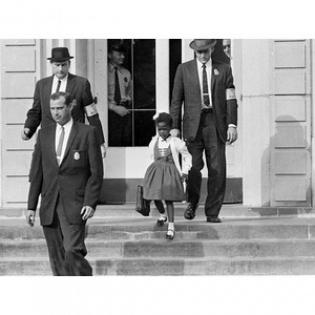Power of Protest
Through two readings, we learn about racist attitudes and practices in the transportation systems that were supported by Jim Crow laws in the 1940s South. When Rosa Parks refused to give up her seat, it was a final stand after years of injustice and continuous acts of protest. We learn how her social action was part of combined efforts and ultimately changed public transportation laws.
The learners will:
- recognize racism in 1940s transportation laws and behaviors and identify how Southern black resistance changed segregation in public transportation.
- explain why Rosa Parks is called the “Mother of the Civil Rights Movement.”
- copies of Birmingham, Alabama: The Forties (handout below)
- projected copy of Terminology (handout below)
- copies of Rosa’s Story (handout below)
- Projected copy of Concluding Quote (handout below)
- website of "Jim Crow Museum of Racist Memorabilia" at Ferris state University
Instructions
Anticipatory Set:
Today we are going to read about the American icon Rosa Parks and learn about the racists attitudes and practices of the time that led to her protest and the Montgomery Bus Boycott. Display the terminology in the handout below as a preview of terms. Allow time for youth to scan and read the definitions that are unfamiliar.
Distribute copies of Birmingham, Alabama: The Forties (handout). Youth people may read this alone or in small groups or listen to a pre-recorded version. They may refer to the projected terminology as they encounter terms in context.
Talk about the attitudes and behaviors in the article and how they relate to institutional racism and injustice today.
Distribute copies of Rosa’s Story (handout) and have the youth read the selection, paying attention to her actions in the context of the time. Be ready to discuss: Why is it important that we see this not as the actions of one woman, but of a whole community?
- If Parks was not the first African American to protest legal segregation in public transportation, why is she remembered as the Mother of the Civil Rights Movement? (Because her action influenced local leaders to protest her arrest, which led to the bus boycott, which ignited the Civil Rights Movement)
- What made the Montgomery Bus Boycott so significant? (It represented a collaborative effort of the community to protest segregation, which was more effective than the earlier individual acts of resistance)
- Identify the factors after her arrest that helped to give rise to the Civil Rights Movement. (Her arrest came one year after the U.S. Supreme Court reversed the “Separate but Equal” doctrine in the ruling of Brown v. Board of Education. Also, the Reverend Martin Luther King, Jr. happened to be a minister at the Dexter Ave. Baptist Church in Montgomery at the time of her arrest.)
Display a copy of the Concluding Quote (handout). Using this a prompt, young people write a brief reflection on what the quote means and how it can relate to them
Philanthropy Framework
-
Strand PHIL.I Definitions of Philanthropy
-
Standard DP 01. Define Philanthropy
-
Benchmark HS.3 Explain and give examples of how a democratic constitution requires and protects philanthropic behavior as a democratic principle.
-
-
-
Strand PHIL.II Philanthropy and Civil Society
-
Standard PCS 02. Diverse Cultures
-
Benchmark HS.2 Give examples from history of how intolerance of ideas, religion, and minorities contributed to social disintegration.
-
Benchmark HS.7 Identify and give examples of the important roles women and minorities have played in the civil society sector in history.
-
-
Standard PCS 03. Philanthropy and Economics
-
Benchmark HS.9 Analyze a major social issue as a "commons problem" and suggest ways the civil society sector could help to resolve it.
-
-
Standard PCS 05. Philanthropy and Government
-
Benchmark HS.10 Discuss the results of private citizen voluntary action intended for the common good on public policy changes.
-
Benchmark HS.12 Explain why private action is important to the protection of minority voices.
-
-
Standard PCS 06. Philanthropy in History
-
Benchmark HS.2 Give an example of individual philanthropic action that influenced national or world history.
-
-
-
Strand PHIL.III Philanthropy and the Individual
-
Standard PI 01. Reasons for Individual Philanthropy
-
Benchmark HS.4 Cite historical examples of citizen actions that affected the common good.
-
-
